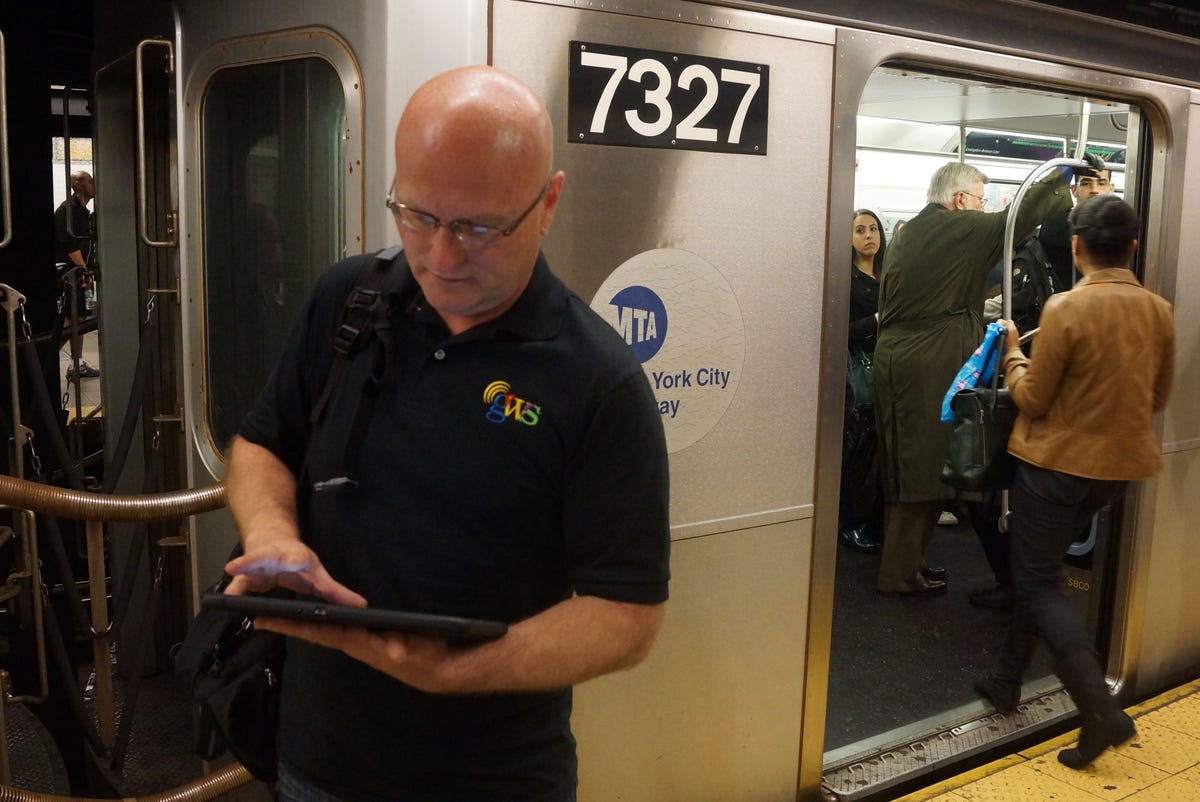
Roger Cheng/CNET
The New York City subway system may run 24 hours a day and represent the most efficient means to get around the metropolis, but it has long been a sore spot for anyone looking to continue their cellular calls.
That has changed a bit over the last few years, with all of the major carriers committing to building out coverage in the stations as the city’s Metropolitan Transit Authority allows it. Mobile testing firm Global Wireless Solutions ran a recent test of the lines in Manhattan, and found the job was far from done for the four national carriers.
“It’s not wonderful,” said Global Wireless CEO Paul Carter. “It’s a bit disappointing actually.”
In a test of the most commonly used subway lines in Manhattan, the 7 train as it runs between Times Square and Grand Central performed the best, with a success rate of 74 percent, according to a study exclusively obtained by CNET. The Westside E train in the 50th Street to Lexington Ave/53rd Street area had a success rate of 52 percent. The E line was among the first to get a cellular hookup.


Roger Cheng/CNET
The same E train line downtown near the financial district and the N, Q, and R lines saw a success rate of 11 percent. The worst line: the F train with only an 8 percent success rate.
The mixed results underscore the difficulties of providing coverage in New York’s old subway line — scores across the nation tend to average in the high 90s. There weren’t any standouts either, with all of the carriers performing similarly.
But Adam Lisberg, a representative for the MTA, criticized the tests as unfair because there is no wireless service south of 14th St. in Manhattan or in the tunnels. The MTA or Transit Wireless, the company installing the cellular network throughout the stations, hasn’t committed to either yet.
There is cellular coverage in 47 stations in Manhattan, and Transit Wireless is ahead of its plans to cover 278 stations by 2017, Lisberg said. You can check out the lit up stations here.
When a phone was able to connect to the network, it would be able to download at 3 megabits per second, Carter said.
Global Wireless Solutions isn’t a publicly known name, but it has spent nearly 20 years testing and measuring network performance. In light of younger firms such as RootMetrics, or the rise of do-it-yourself Speedtest.net, the company and CEO Carter felt it was time to get more vocal about its own business.


Roger Cheng/CNET
These firms are increasingly important as the wireless carriers each scramble to lay claim to some advantage, whether it’s the most reliable or fastest network. Sprint now touts itself as the nation’s newest network, with the inherent implication that newer is better.
Global Wireless Solutions itself claims to have among the more rigorous testing methods in the industry, with “8 million miles of data collection,” and 10,000 miles of testing in New York alone. The company uses a standard smartphone, typically a Samsung Galaxy S phone, to do the tests, and has equipment to ensure that any issues are related to the network, and not some outside factor.
“We need to be able to stand behind the validity of the data,” Carter said.
The firm doesn’t disclose its findings publicly, and Carter wouldn’t make a call on which carrier had the best network.
But when it comes to the New York subway, none of the carriers should be bragging.
“It’s apparent that networks and the MTA alike have a long road ahead of them,” he said.
Here’s the full ranking of the subway lines:
- 1. 7 train (Times Square to Grand Central) – 74 percent success rate
- 2. E train (50th Street to Lexington Ave/53rd Street) – 52 percent success rate
- 3. 6 train (28th Street to Grand Central) – 35 percent success rate
- 4. B, D trains (Columbus Circle to Grand Street) – 23 percent success rates
- 5. 1 train (Columbus Circle to South Ferry) – 20 percent success rate
- 6. A, C trains (Columbus Circle to Fulton Street) – 16 percent success rates
- 7. L train (8th Ave to 1st Ave) – 15 percent success rate
- 8. 2, 3 trains (Chambers Street to Wall Street) – 14 percent success rates
- 9. J, Z trains (Delancey Street to Broad Street) – 12 percent success rates
- 10. (Tied) E train (Canal Street to World Trade Center) – 11 percent success rate; N, Q, R trains (Lexington Ave/59th Street to South Ferry) – 11 percent success rates
- 11. F Train (Lafayette Street to East Broadway) – 8 percent success rate
Updated at 1:11 pm PT: To include a comment from the MTA



